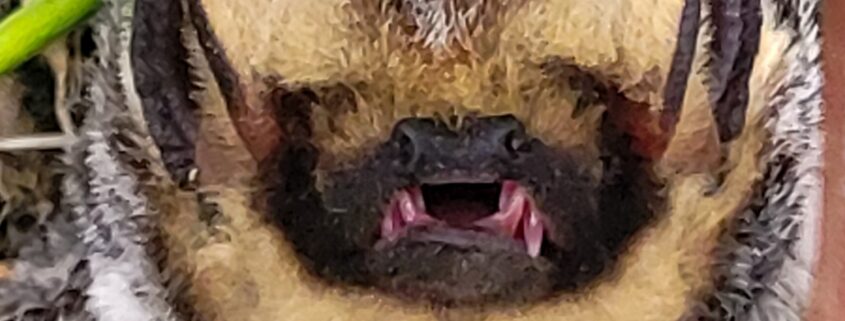By Rebecca K. O’Connor | Contributing Columnist
In the spring 2023, I was preparing to go on a wildflower hike with Jack Easton, the Rivers & Lands Conservancy’s retired executive director, when our plans were disrupted. My neighbor marched across the street with something pinched between his fingers and thrust it at me. I took it without thinking. I found myself holding a hissing bat and left with curt instructions to fix it.
It is true that I spent a good part of my professional life as a bird trainer and bats are the only mammal that can truly fly, but they are nothing like birds. I looked pleadingly at Jack, a seasoned biologist, and he shrugged. He had never held a bat either, but we found a pair of gloves and set about figuring out where we could safely tuck the palm-sized, flying mammal until nightfall.
A little bit of research told us that our charge was a hoary bat (Lasiurus cinereus) and that it could be found almost anywhere in California. A solitary species, hoary bats prefer to roost alone in trees where they snugly wrap their furry body with their leathery wings, cover their feet with their furry tail, and look like a crumpled hanging leaf. I had no idea there were solitary bats, let alone bats that lived in my pine trees.
I only knew one great fact about bats. Tequila-producing agave plants rely on nectar-sipping bats as their primary pollinator. One of these species, the lesser long-nosed bat (Leptonycteris yerbabuenae) arrives seasonally in the southwestern United States from Mexico. In 1988, it was estimated there were fewer than 1,000 individuals left. Thanks to the work of biologists and citizen scientists in both countries by 2018 there were nearly 200,000 individuals and it was the first bat species de-listed from the Endangered Species Act. I will always embrace these rare opportunities to celebrate conservation success, but I will admit that improving the future of tequila and agave syrup also made me happy.
Now I know that there are 25 known species of bats in California and 16 of these species are considered sensitive. Some species, like hoary bats, are very difficult to study and little is known about their population size and habits. However, scientists agree that most bat species are declining.
Recognizing the importance of bats to their ecosystems and to humans, Senate Bill No. 732 was signed into law, and as of Jan. 1, 2024, the pallid bat (Antrozous pallidus) is now the state bat of California. The pallid bat resides in a wide range of California ecosystems, including oak woodlands, deserts and forests, where it predates mosquitoes, flies and other agricultural pests. According to the bill, bats have provided more than $1 billion worth of pest control benefiting agriculture in California. Their taste for bark beetles and wood borers also reduces wildfire risk.
The hope is that having a state bat will encourage research, conservation and dispel the many myths about them. I will admit that I believed bats found in the daytime were likely to be rabid, but I was quickly schooled that less than 6% tested carry rabies. They may get knocked from their roost by a predator, young bats may be separated from their mother, they may be injured or just exhausted. Often, if they are left in a place safe from predators, they will return to the sky in the evening. Unfortunately, however, if you are bitten by a bat, the bat must be killed to be tested. Anyone aiding a bat should wear gloves.
The best way to help our insect-eating and cactus pollinating friends is to preserve habitat. Wild open spaces like those preserved by Rivers & Lands Conservancy offer bats hunting grounds where they can thrive as well as natural features and woodlands where they can roost. If you have trees and palms that need trimming, get them trimmed by the end of February while bats are still hibernating elsewhere. We can also help bats by installing bat houses on our properties while reaping the benefits of less mosquitoes.
When the sun set on my bat adventure, the hoary bat returned to its mysterious nocturnal errands. We were all delighted to have helped it along and I expect that for years to come, I will be squinting up into my pines looking for bats masquerading as leaves. I may never spot one, but I hope they will always be up there.






